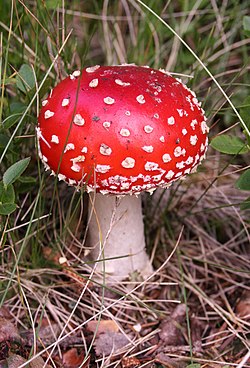Mushroom
fleshy, spore-bearing fruiting body of a fungus, typically produced above ground on soil or on its food source From Wikipedia, the free encyclopedia
A mushroom (also called a toadstool) is the part of a fungus that is comparable to the fruit of a plant. Unlike plants, mushrooms do not use sunlight to generate energy for themselves. Some mushrooms are edible, and are used for cooking in many countries, such as China, Korea and Europe. Other mushrooms, however, are poisonous, and can cause severe illness or death if eaten. People who search for edible mushrooms are called mycophagists, meaning "mushroom eater", while the act itself is called "mushrooming".[1] Mushrooms have been known to support bone health and to regulate blood sugar in diabetics. It is available in different colours and shapes.[2]
| Mushroom | |
|---|---|
 | |
| The toxic mushroom Amanita muscaria, commonly known as "fly agaric." | |
| Scientific classification | |
| Kingdom: | |
| Division: | |
Kinds of mushrooms

- Agarics (includes very poisonous, and hallucinogenic kinds)
- Boletus (includes poisonous and edible kinds)
- Chanterelles (edible)
- Coral fungi (usually edible)
- Cap fungi (usually edible) [citation needed]
- Jelly fungi (usually edible)
- Polypores (similar to boletes)
- Psychedelic (also known as shrooms)
- Puffballs (usually edible)
- Stinkhorns (usually edible, but has a stench)
- Tooth fungi
Structure of mushrooms
Most mushrooms have a stem and a cap. The bottom of the cap usually has gills to hold spores, however, some mushrooms, such as the Porcini, have pores under the cap.
References
Other websites
Wikiwand - on
Seamless Wikipedia browsing. On steroids.
